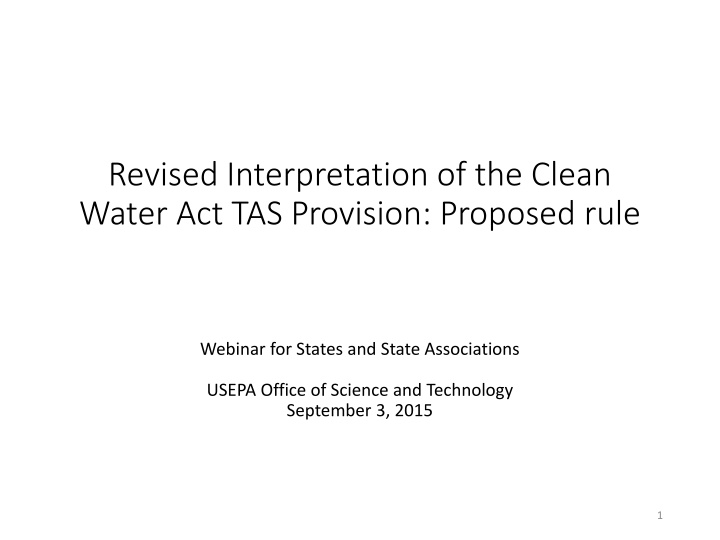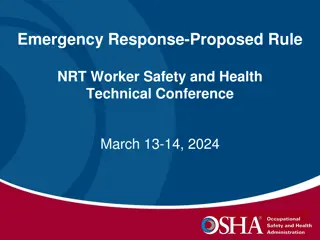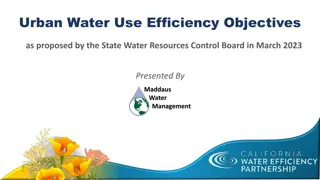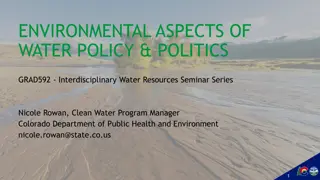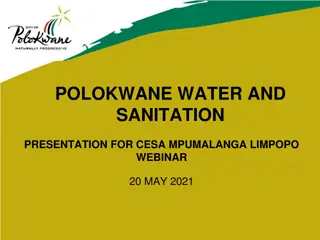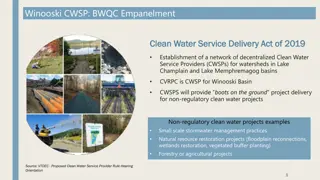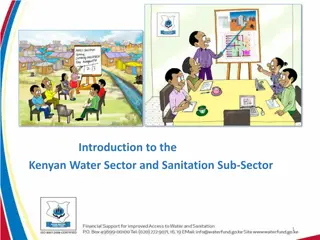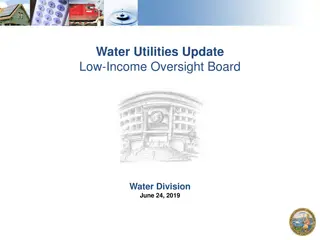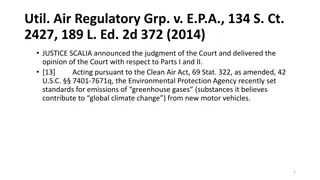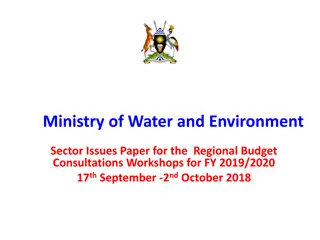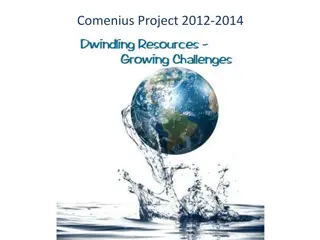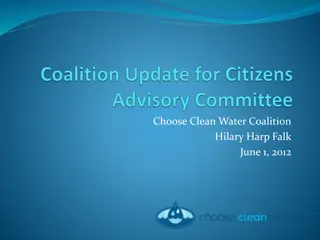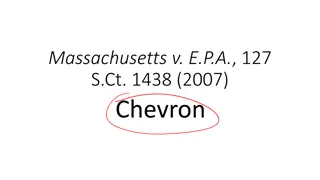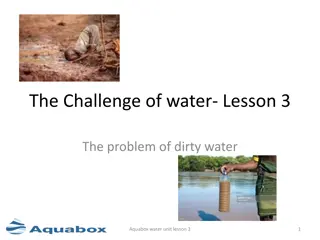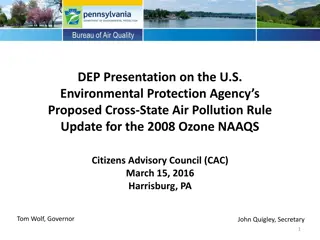Proposed Rule Webinar for Clean Water Act TAS Provision
Waters on many Indian reservations lack water quality standards under the Clean Water Act, hindering human health and environmental protection. The EPA proposes streamlining the Tribal Assumption of Section 303(d) Waters for easier tribal involvement in water quality protection. Learn about the background, key terms, and the EPA's proposal in this webinar.
Download Presentation

Please find below an Image/Link to download the presentation.
The content on the website is provided AS IS for your information and personal use only. It may not be sold, licensed, or shared on other websites without obtaining consent from the author.If you encounter any issues during the download, it is possible that the publisher has removed the file from their server.
You are allowed to download the files provided on this website for personal or commercial use, subject to the condition that they are used lawfully. All files are the property of their respective owners.
The content on the website is provided AS IS for your information and personal use only. It may not be sold, licensed, or shared on other websites without obtaining consent from the author.
E N D
Presentation Transcript
Revised Interpretation of the Clean Water Act TAS Provision: Proposed rule Webinar for States and State Associations USEPA Office of Science and Technology September 3, 2015 1
Summary Waters on the majority of Indian reservations do not have water quality standards (WQS) under the Clean Water Act (CWA) to protect human health and the environment. Only 40 of over 300 tribes with reservations Have been found eligible to be treated in a similar manner as a state (TAS) for WQS, AND Have adopted WQS that EPA has approved EPA proposes to streamline how tribes apply for TAS for the WQS program and other CWA regulatory programs. This would reduce the burden on applicant tribes and facilitate tribal involvement in protecting reservation water quality without changing statutory or regulatory requirements. 2
Todays Topics Background EPA s Interpretation Since 1991 Developments Supporting a Reinterpretation EPA s Proposal Next Steps How to Comment on the Proposal How to Obtain More Information 3
Background Key Terms TAS treatment of tribes in a similar manner as a state, for the purposes of administering EPA programs. Tribe one of the 566 Indian tribes that are federally recognized, of which over 300 have reservations. Reservation either a formal reservation or tribal trust land outside of a formal reservation. Nonmember fee lands lands within a reservation that are owned outright ( in fee simple ) by nonmembers of the tribe. Regulatory program one of the following CWA programs: Sec. 303(c) water quality standards Sec. 303(d) listings and TMDLs Sec. 401 water quality certifications Sec. 402 NPDES permits Sec. 404 dredge or fill permits 4
Background CWA TAS Provision Section 518 of the Clean Water Act authorizes EPA to treat a tribe in a similar manner as a state for purposes of a regulatory program if: 1. The tribe is federally recognized and has a reservation.* 2. The tribe has a governing body carrying out substantial governmental duties and powers. 3. The functions to be exercised pertain to the management and protection of water resources within the reservation. 4. The tribe is reasonably expected to be capable of carrying out the functions of the program. * Reservation means all land within the limits of an Indian reservation notwithstanding the issuance of any patent, and including rights of way running through the reservation. 5
Background Tribes with TAS Regulatory programs 303(c) WQ standards and 401 certifications . .50 tribes approved 303(d) listings/TMDLs . TAS process under consideration 402 NPDES .. . ..some interest, no tribes approved 404 dredge or fill . . .limited interest, no tribes approved Grant programs* 106 management programs .. 269 tribes approved 319 nonpoint source management ..183 tribes approved * Grant programs are not discussed further in this presentation. Tribal grant applicants do not need to demonstrate regulatory jurisdiction. 6
EPAs Interpretation since 1991 EPA has followed a cautious approach that requires each applicant tribe to demonstrate its inherent authority under principles of federal Indian common law in order to regulate waters and activities on its reservation. For example, a tribe with nonmember-owned fee lands on its reservation must gather data to show it meets the Montanatest EPA has stated its approach was subject to change in the event of further congressional or judicial guidance. 7
Developments Supporting a Reinterpretation EPA s analysis is presented in the proposal. It includes references to: Federal district court case in Montana (1996) Language supports the interpretation that section 518 includes a congressional delegation of authority EPA s interpretation of similar statutory language in the Clean Air Act (1998) Congressional delegation of authority applies to reservation areas Federal D.C. Circuit Court of Appeals decision upholding EPA s 1998 CAA approach (2000) Upheld EPA interpretation that the Clean Air Act tribal provision includes a congressional delegation of authority. Observed favorably that section 518 of the CWA appears amenable to the same approach. 8
EPAs proposal EPA proposes to conclude definitively that section 518 of the Clean Water Act includes an express delegation of authority by Congress to Indian tribes to administer regulatory programs over their entire reservations, subject to the eligibility requirements in section 518. 9
EPAs proposal would Eliminate the need for applicant tribes to demonstrate inherent authority to regulate under the CWA. Allow tribes to implement the congressional delegation of authority unhindered by requirements not specified in the statute. Bring EPA s treatment of tribes under the CWA in line with EPA s treatment of tribes under the Clean Air Act. 10
EPAs proposal would NOT revise any regulatory text. For example, EPA s regulations would continue to: Require tribes to identify the boundaries of the reservation areas over which they seek to exercise authority. Require EPA to provide adjacent state(s), tribe(s), and other appropriate governmental entities an opportunity to comment to EPA on an applicant tribe s assertion of authority. 11
EPAs proposal would NOT affect the geographic scope of TAS. It would neither expand nor contract the geographic scope of potential tribal TAS eligibility. NOT affect any existing limitations on tribal criminal enforcement authority. The proposal relates solely to civil regulatory authority. NOT affect the 50 previous approvals of tribal TAS for water quality standards. NOT affect the scope of existing state regulatory programs approved by EPA under the Clean Water Act. NOT change EPA s case-by-case approach to evaluating the full record in special circumstances. 12
Next Steps Proposed interpretive rule published Tribal consultation and coordination process begins Outreach to states begins Aug. 7, 2015 EPA outreach to public, tribes, states 60-day public comment period ends Tribal consultation and coordination process ends Outreach to states ends Oct. 6, 2015 EPA reviews, analyzes comments and issues If finalized: Final rule published Mid-2016 Until the proposal is finalized, EPA will continue to process tribal applications for TAS under its 1991 interpretation of the CWA. 13
How can states participate in the process? See EPA s Aug. 7, 2015 letter and fact sheet mailed to state associations. Available in the email acknowledging your registration, or from Thomas Gardner, gardner.thomas@epa.gov, or (202) 566-0386. Participate in EPA s webinar for the public (for those who miss this state webinar) Thursday, Sept. 10, 2015 at 2:00-3:30 p.m. EDT. Register at http://www.horsleywitten.com/tasinfo or call Erin Cabral at 508-833-6600. 14
How can states provide comments on the proposal? Provide comments to the public docket not later than Oct. 6: To www.regulations.gov (use Docket ID No. EPA-HQ-OW- 2014-0461) By email, letter, fax, or hand delivery to addresses in FR notice 15
For more information: See Fact Sheet, FAQs, more on EPA s website at http://water.epa.gov/scitech/swguidance/standard s/wqslibrary/tribal.cfm For questions on consultation/coordination: Thomas Gardner, gardner.thomas@epa.gov, (202) 566-0386 For any other questions: Fred Leutner, Leutner.fred@epa.gov, (202) 566-0378 16
Questions? We will now consider Questions from the Questions chat box Type in at any time Questions from the phone lines Wait for instructions 17
